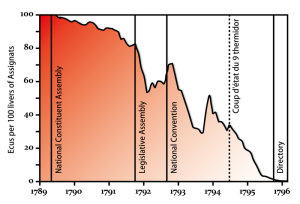In a previous article I pointed out the possible existence of a 4666 day (= 666 weeks) and a 88.37 year cycle in the market. Of course, with only 200 years of observed stock market history we have little proof for it.
One reader asked whether there are even longer cycles we could possibly consider.
Yes, there are, but then we have even less data to confirm them. However, we can to some extent use data of famous financial panics and crises, which occurred already before we had official stock markets.
And long term climate cycles can also offer clues. I do not think that planets influence the stock market directly. But planetary cycles can and do influence climate and weather, and weather events can influence people’s mood and their spending patterns. So, planetary cycles can influence the economy (and by extension the stock market) indirectly, through the effects they have on the solar cycle and on long term climate.
For example, long term Nile records have provided evidence for a 88 year and a ~200 year cycle in the water levels. See: NASA Finds Sun-Climate Connection in Old Nile Records
A study of 9400 years of reconstructed solar data has also confirmed long term cycles of 88 years and 208 years. These are known as the Gleissberg and Suess cycles. See Abreu et al.: http://www.aanda.org/articles/aa/pdf/2012/12/aa19997-12.pdf
So, it is not a big stretch to propose that these cycles may have economic effects, as it is clear that annual rainfall and temperatures influence a lot of different sectors.
Thus, besides 88 years we can also look for 208 year patterns. Interestingly, these periods do indeed show up quite frequently when we look at the most famous speculative bubbles and crashes.
One of the earliest recorded bubbles was the Mississippi Company and the South Sea Bubble, which peaked in 1720. Well, 1720 + 208 = 1928, which was of course near the peak of the 1920s speculative stock mania.
Another period of rampant speculation ended with the Panic of 1792. 208 years later we had the dot.com bubble, again rampant speculation, which ended in the year 2000.
Another interesting case was the Panic of 1796-97, which was a real estate bubble (land speculation), affecting Europe and the USA. Adding 208 years we find 2005, which was close to the top of the most recent real estate bubble.
Not only that, 1796 + 88 years = 1884, which leads us to the Panic of 1884, which was a banking crisis.
Similarly, the Panic of 1819, was followed by the Panic of 1907, again 88 years later.
The 1901 crash, points to 1989 if we add 88 years. Not a perfect match, but we had the crash of 1987 and the Nikkei crash in 1990.
Then there was the Depression of 1920-21, followed 88 years later by the Great recession of 2008-09.
So, what we see is that similar crises are often separated by these 88 year and 208 year periods.
Sometimes they also return to the same place after 88 years. In France the value of assignats (an early experiment with QE) crashed to near zero in 1794, and that got things really going in the French revolution. See in this chart (click for larger image):

(source: http://en.wikipedia.org/wiki/File:The_value_of_assignats%281789-1796%29.png )
Exactly 88 years later the Paris stock market crashed in 1882.
Based on this crash cycle, we should thus watch out in 1929 + 88 = 2017 as the next year to bring us a major stock market mania and crash.
Where do these 88 year and 208 year cycles come from?
It are combined planetary cycles.
88.37 years is the triple Saturn cycle. It is also 8 solar cycles and 10 lunar precession cycles. The lunar precession cycle (8.85 years) is often overlooked, but actually quite important as it determines when we get spring tides and plays a role in weather and climate as well.
The 208 year cycle is equal to 19 solar cycles and 11 Metonic cycles. It is also 11.5 Saros cycles. It is 10.5 times the Jupiter-Saturn synodic period (19.8589 years), and 15 times the Jupiter-Uranus synodic period (13.8119 years).
Through a more complex interaction, a 208 year periodicity also emerges from the lunar cycle. See this article.
The 4666 day cycle, is a shorter term cycle that resonates closely with a bunch of planets.
Jupiter and Neptune are conjunct every 4668 days (heliocentric) or 12.8 years.
Venus and the Earth are conjunct every 1.59869 years. 4 * 1.59869 = 6.39476 years
Earth and Mars are conjunct every 2.13535 years. 3 * 2.13535 = 6.40606 years
Venus and Mars are conjunct every 0.914227 years. 7 * 0.914227 = 6.39959 years
The implication is that every 6.4 years the planets Venus, Earth and Mars come back to the same relative position in the sky. Every 12.8 years (~4666 days), the planets Venus, Earth, Mars, Jupiter and Neptune return to the same relative position in the sky.
If we combine the 88.37 year cycle with the 208 year cycle, then there is a resonance at 153.6 years.
153.6 years = 12 * 12.8 years (4666 days).
153.6 years = 14 * 10.97 years (= 14 solar cycles).
Now it all fits together.
Danny






Hi,
I am in France and looked in planetary cycles a long time ago.
Have you also looked to Mercury cycle of 88 days ?
Gil
Hi Gil,
You are welcome to check out this article on the cycle of Mercury: https://lunatictrader.com/2013/10/22/the-myth-of-mercury-retrograde/
Danny
Fall 2019…we are there, now!
Yes. And the question is?